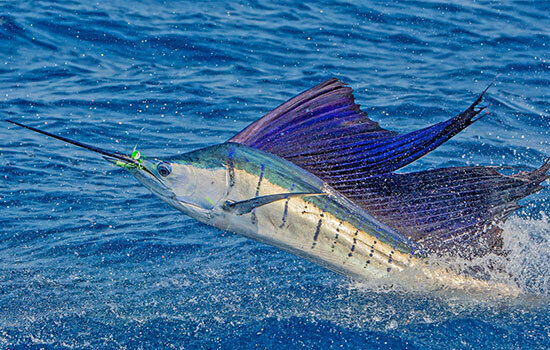When it comes to speed, the ocean is home to some of the fastest creatures on Earth. From sleek predators to agile swimmers, aquarium/52-marine-animals.html">marine animals have evolved extraordinary adaptations to move swiftly through water. In this article, we will explore the fastest animal in the ocean, dive into speed comparisons, and uncover the science behind their incredible abilities.
The title of the fastest animal in the ocean belongs to the sailfish, capable of reaching speeds up to 68 miles per hour (110 km/h). Known as the "Cheetah of the Sea", the sailfish’s speed is unmatched among marine creatures.
Key Features of Sailfish
Body Structure: Its streamlined body reduces drag in water.
Fins: Its long, retractable dorsal fin (the sail) enhances maneuverability.
Muscle Power: Specialized muscle fibers enable rapid bursts of energy.

The black marlin, a close contender, can swim at speeds of around 50 mph (80 km/h), making it another top competitor in the ocean's speed race.
Here’s a list of some of the fastest marine creatures and their top speeds:
| Animal | Top Speed | Notes |
|---|---|---|
| Sailfish | 68 mph (110 km/h) | Sleek design, burst swimming capability |
| Black Marlin | 50 mph (80 km/h) | Renowned for long-distance speed |
| Swordfish | 48 mph (77 km/h) | Fast due to its elongated, streamlined body |
| Mako Shark | 45 mph (72 km/h) | Top predator with incredible agility |
| Bluefin Tuna | 43 mph (69 km/h) | Built for endurance and speed |
| Orca (Killer Whale) | 34 mph (56 km/h) | Efficient hunter with powerful tail strokes |
| Dolphin (Common) | 37 mph (60 km/h) | Intelligent and playful swimmers |
| Wahoo | 47 mph (75 km/h) | Known for its fast and short bursts |
| Yellowfin Tuna | 40 mph (64 km/h) | A close relative of the bluefin tuna |
| Bonito | 40 mph (64 km/h) | Agile predator in the pelagic zone |
Marine animals achieve remarkable speeds due to their unique adaptations.
Streamlined Bodies: Most fast swimmers have hydrodynamic shapes that reduce drag.
Powerful Muscles: Fast fish like the sailfish and black marlin possess muscle fibers that produce quick, explosive movements.
Fins and Tail Design: Crescent-shaped tails, as seen in tuna, allow for efficient propulsion.
Behavioral Strategies: These animals rely on speed to escape predators or catch prey, making it a vital survival trait.
Sailfish vs. Black Marlin: While the sailfish holds the top spot, the black marlin’s speed over longer distances gives it an edge in endurance.
Sharks vs. Tunas: The mako shark’s agility and speed allow it to outpace many prey species, but tuna are designed for sustained high-speed travel.
Mammals: Orcas and dolphins, though not as fast as fish, use their intelligence and group hunting strategies to compensate.
The ability to swim at such high speeds boils down to physics and biology:
Buoyancy and Density: Water's density requires animals to minimize resistance, which explains the evolution of streamlined bodies.
Fin Mechanics: Pectoral fins act as stabilizers, while caudal fins generate thrust.
Muscle Composition: Marine speed champions have a high proportion of red and white muscle fibers, allowing for a mix of endurance and explosive power.
Evolutionary Adaptations: Over millions of years, fast aquarium/52-marine-animals.html">marine animals have developed traits like sharp fins and elongated bodies to survive.
Role of Speed in Predation: Speed is a critical factor for predators like the mako shark, enabling them to catch elusive prey.
Human Inspiration: Understanding marine speed informs advancements in technology, such as designing hydrodynamic boats.
How does the sailfish stack up against speed champions on land and in the air?
Cheetah (Land): Tops at 75 mph (120 km/h), slightly faster than the sailfish.
Peregrine Falcon (Air): Reaches dive speeds of 240 mph (386 km/h), making it the ultimate speed champion across all environments.
Q: What makes the sailfish the fastest?
A: Its combination of a streamlined body, powerful muscles, and retractable fins.
Q: Can dolphins outswim sailfish?
A: dolphins.html">Dolphins are fast but lack the burst speed of fish like sailfish or marlins.
Q: How fast can tuna swim?
A: Bluefin tuna can reach speeds of 43 mph (69 km/h), making them one of the fastest fish.
The ocean’s fastest animals showcase nature’s ingenuity and adaptability. From the lightning-fast sailfish to the endurance-driven bluefin tuna, marine creatures are perfectly designed for their watery world. Understanding their speed not only amazes us but also inspires technological and scientific advancements.
So next time you marvel at the ocean, remember its true speed champions, racing unseen beneath the waves!
animal tags: sailfish
We created this article in conjunction with AI technology, then made sure it was fact-checked and edited by a Animals Top editor.